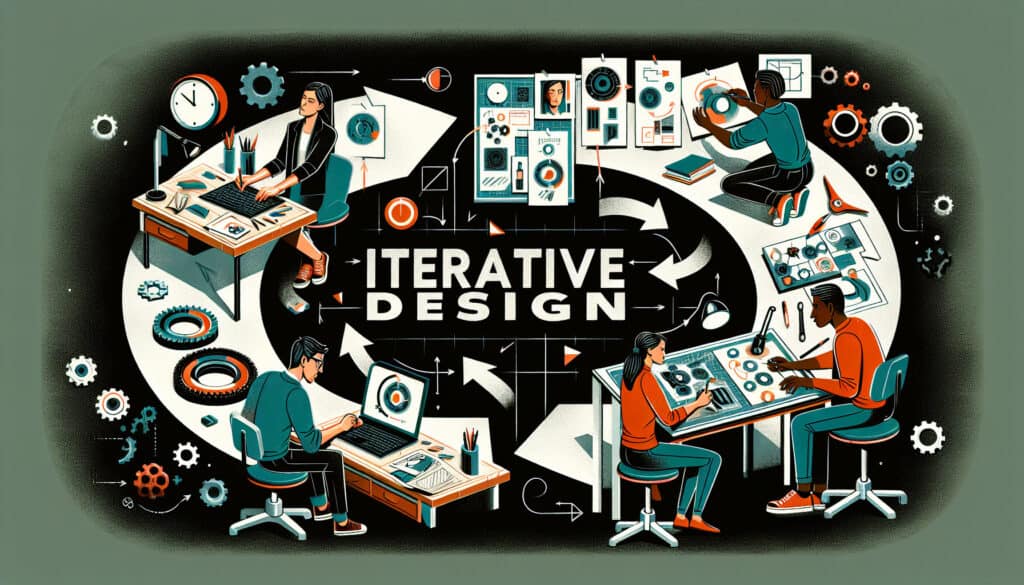A design methodology based on a cyclic process of prototyping, testing, analyzing, and refining a product or process.
- Methodologien: Lean Sigma, Herstellung
Iterative Design

Iterative Design
- Agile Methodik, Kontinuierliche Verbesserung, Entwurfsprozess, Überprüfung des Designs, Design Denken, Iterative Entwicklung, Prototyping, Benutzerzentriertes Design
Zielsetzung:
Wie es verwendet wird:
- A design process that involves creating a series of prototypes that are tested and refined in a cyclical manner. This allows designers to get feedback from users early and often, and to make improvements to the design throughout the development process.
Vorteile
- Allows for flexibility and adaptation throughout the design process; Reduces the risk of failure by getting feedback early and often.
Nachteile
- Can be time-consuming and may not be suitable for projects with tight deadlines; Can lead to scope creep if not managed carefully.
Kategorien:
- Maschinenbau, Produktdesign
Am besten geeignet für:
- Developing new products and services in a flexible and nutzerzentriert way.
Iterative Design is particularly beneficial in industries such as consumer electronics, automotive, software development, and healthcare, where rapid technological advancements and user preferences are constantly evolving. This methodology is typically employed during the product development phase, where designers and engineers collaborate with end-users to create multiple versions of a product, each refined based on user feedback, usability studies, and testing results. By initiating this process, cross-functional teams including designers, product managers, engineers, and marketing representatives engagieren in brainstorming sessions that encourage creative solutions to user problems. For example, in software development, beta testing phases are a form of Iterative Design where software can undergo multiple rounds of revisions based on user interactions, ultimately leading to a more polished final product. In the consumer electronics sector, companies like Apfel and Samsung often release prototypes to small user groups to gather detailed feedback on design, functionality, and user experience before launching the final version. This approach not only accelerates innovation but also minimizes the risk of market failure since real user expectations and experiences are considered in each iteration, allowing teams to pivot quickly in response to feedback without substantial resource investment in a single untested design.
Die wichtigsten Schritte dieser Methodik
- Define user needs and requirements based on stakeholder input.
- Sketch initial design concepts that address user needs.
- Create low-fidelity prototypes to visualize concepts.
- Conduct usability testing with target users on prototypes.
- Gather user feedback and identify areas for improvement.
- Refine design based on feedback and insights.
- Develop higher-fidelity prototypes incorporating revisions.
- Repeat usability testing with updated prototypes.
- Continue iterating until user satisfaction and design goals are met.
Profi-Tipps
- Benutzer einbeziehen Menschen into your prototypes to address specific needs and preferences of different user segments.
- Utilize A/B testing on design variations to gather comparative data and make informed decisions based on user behavior.
- Implement rigorous documentation at each iteration to track changes, decisions, and user feedback systematically, facilitating later phases of development.
Verschiedene Methoden lesen und vergleichen, Wir empfehlen die
> Umfassendes Methoden-Repository <
zusammen mit den über 400 anderen Methoden.
Ihre Kommentare zu dieser Methodik oder zusätzliche Informationen sind willkommen auf der Kommentarbereich unten ↓ , sowie alle ingenieursbezogenen Ideen oder Links.
Historischer Kontext
1949
1950
1950
1960
1960
1960
1960
1940
1950
1950
1958
1960
1960
1960
1960
(wenn das Datum nicht bekannt oder nicht relevant ist, z. B. "Strömungsmechanik", wird eine gerundete Schätzung des bemerkenswerten Erscheinens angegeben)















Verwandte Artikel
Management der Produktionsabläufe (MOM)
Fertigungsausführungssystem (MES)
Produktionslenkungsplan
Manuelle Prüfung
Bewertungsbögen für die manuelle Handhabung (MAC)
ManTRA (Instrument zur Risikobewertung manueller Tätigkeiten)